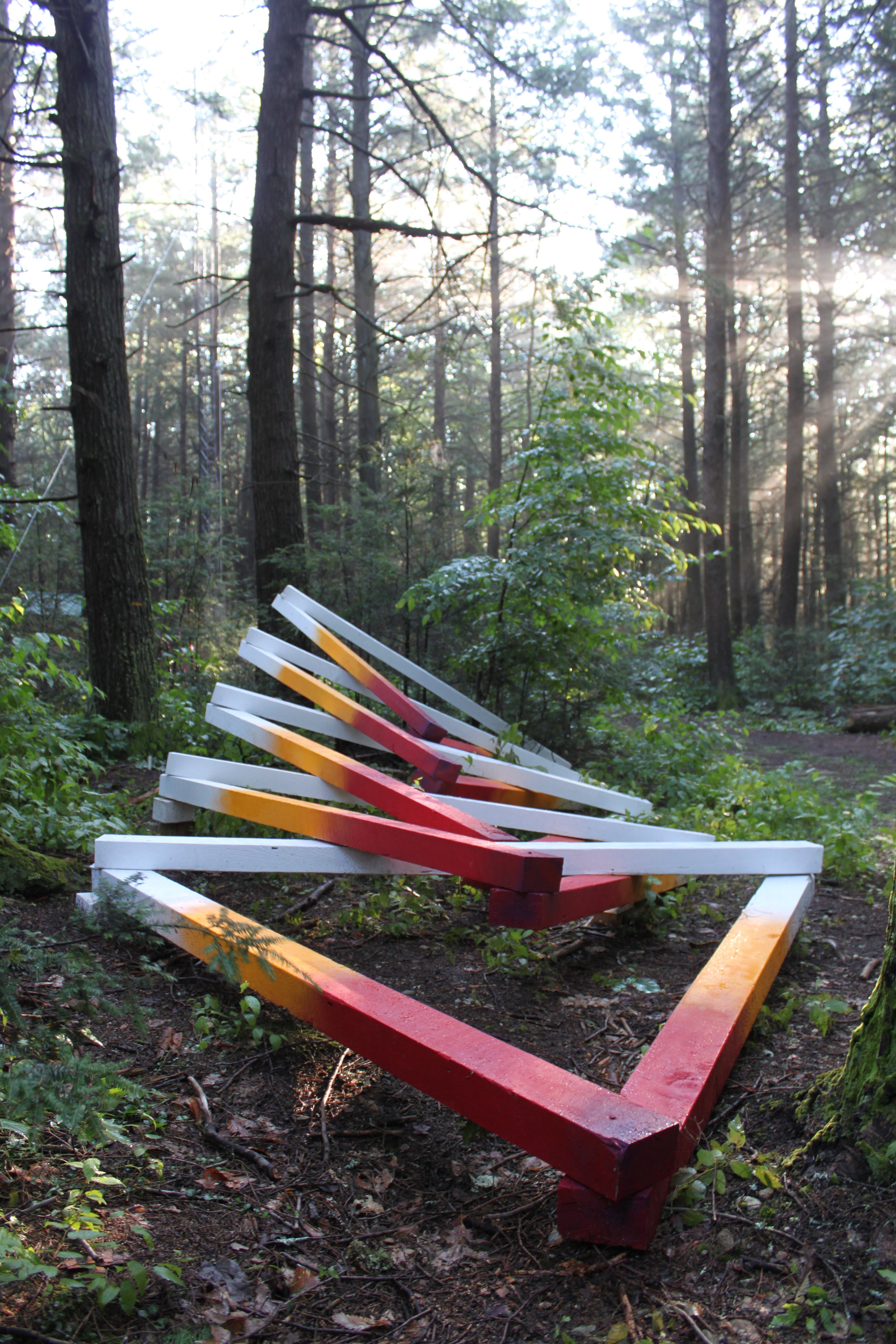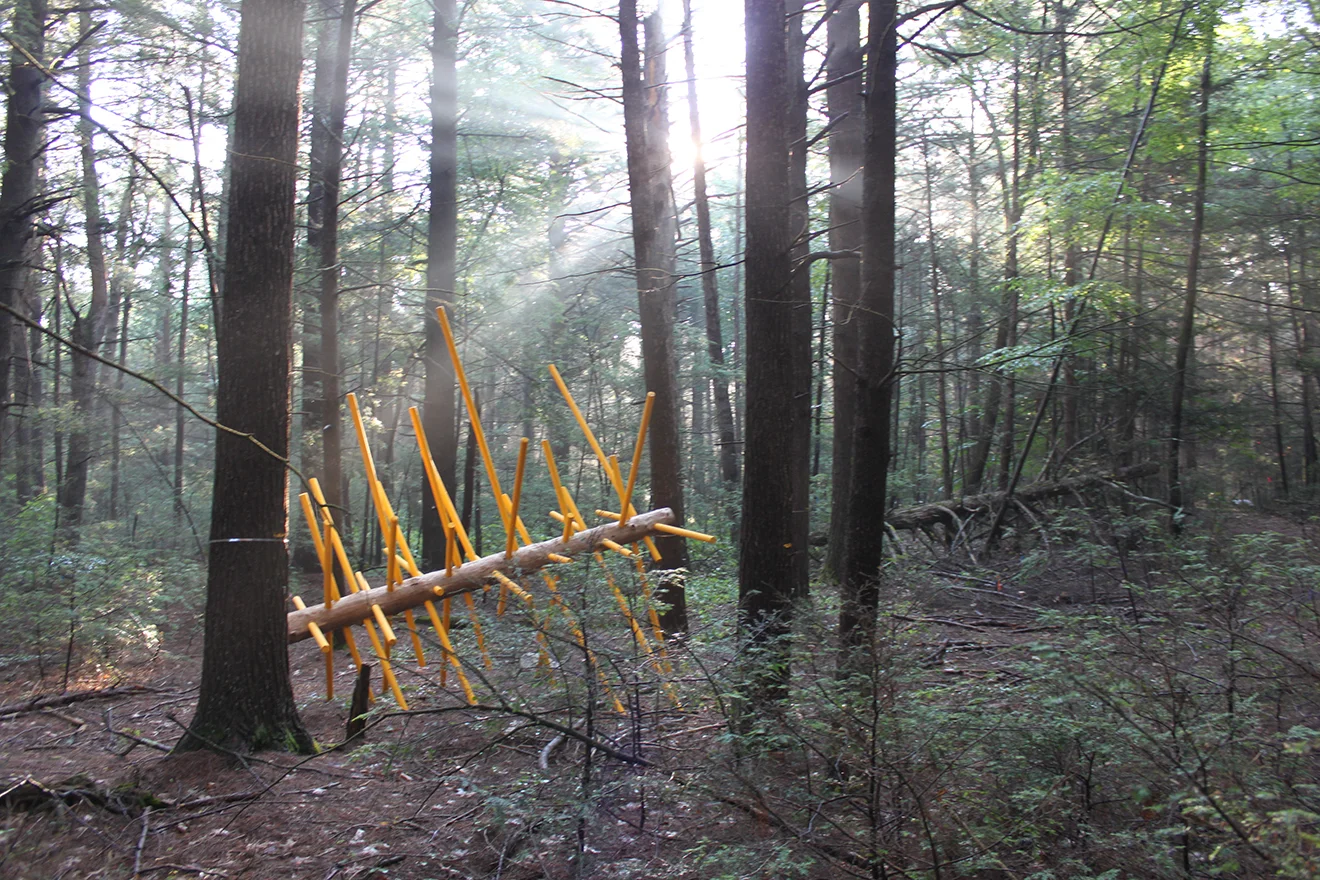Hemlock Hospice Trail
Hemlock Hospice; landscape ecology, art, and design
Location: Harvard Forest, Petersham, Massachusetts, USA
Exhibition Run: October 7, 2017 to November 18, 2018.
Hemlock Hospice was a year-long, art-based interpretive trail by David Buckley Borden, Aaron M. Ellison, and their team of interdisciplinary collaborators. This immersive site-specific science-communication project told the story of the ongoing demise of the eastern hemlock tree at the hands (and mouth) of a tiny aphid-like insect, the hemlock woolly adelgid (HWA) from Asia. Scientists project that the hemlock forests in Massachusetts will functionally disappear by 2025. While telling the story of the loss of eastern hemlock, the project addressed larger issues of climate change, human impact, and the future of New England forests.
David Buckley Borden, an interdisciplinary artist and designer, was in residence at the Harvard Forest for a year as a 2016/2017 Charles Bullard Fellow in Forest Research. During that period, he collaborated with Harvard scientists on interdisciplinary art-design-science communication projects involving landscape installations and art-based interpretive trail design. The Hemlock Hospice installation was created in collaboration with Senior Ecologist Aaron Ellison, and designed to communicate the latest scientific research on eastern hemlock and HWA at Harvard University’s center for forest research and education. Hemlock Hospice featured 18 sculptures installed on an interpretative trail through a nearly 200-year-old grove of hemlocks of Harvard Forest.
Says Borden, “Artists and designers can play a unique role in communicating the reality of science. As environmental challenges become more critical, scientists are increasingly asked to provide vital information to policy makers, community groups, and individuals. During my time as a Bullard Fellow I answered the question ‘How can art and design support science communication to foster cultural cohesion around ecological issues and help inform ecology-minded decision making.’”
“A field-based installation that blends science, art, and design, Hemlock Hospice respects the eastern hemlock and its ecological role as a foundation forest species; promotes an understanding of the adelgid; and encourages empathetic conversations among all the sustainers of and caregivers for our forests—ecologists and artists, foresters and journalists, naturalists and citizens—while fostering social cohesion around ecological issues,” adds Ellison. “As a scientist, I study how our forests may respond to the loss of this ‘foundation’ tree species,” he continues. “As a human being, I cry, I mourn, and I look to the future for hope. David’s installation tells the story of the hemlock in a new way, communicating why so many scientists and poets care about it, and what their plight tells us about the future of our environment.”
While the Hemlock Hospice trail took visitors on a journey of the disappearance of a species at the Harvard Forest, an accompanying exhibition inside the Fisher Museum curated by Penelope Taylor extended the story of the Museum’s famous dioramas with a collection of Borden’s silkscreen prints, illustrations, and art-objects created collaboratively as part of his Fellowship.
Both Hemlock Hospice and the museum exhibition were on display through November 2018; together, they imagined a future ecology supported by a new creative wave of interdisciplinary science-communication.
The interdisciplinary Hemlock Hospice project was made possible by both leading Harvard scientists and an A-team of creative professionals with a wonderfully diverse set of skills and interests. The year-long project was collaborative in intent, process, and production. Beyond the artwork itself, the final project can be viewed as an allied exhibition of science, art, and design talent from across the country. Learn more about the Hemlock Hospice collaborators here.
If you would like to join the conversation and help spread the word about how designers, scientists, and communities can work together to play an active role in imagining and creating a sustainable environment for our future, please reach out to David Buckley Borden and Dr. Aaron M Ellison at borden@fas.harvard.edu and aellison@fas.harvard.edu.
David Buckley Borden’s work was supported by a Charles Bullard Fellowship in Forest Research at Harvard University. Additional financial support for design and fabrication was provided by the Harvard Forest through research grants to David R. Foster and Aaron M, Ellison from the U.S. National Science Foundation (DEB 12-37491 and DBI 14-59519).

Wayfinding Barrier, No. 2, installation at Harvard Forest, 2 x 3.5 x 4 feet, wood, acrylic paint, vinyl, sheet metal, aluminum tape, and recycled ant nests and specimen box, 2017. Collaborators: David Buckley Borden, Jack Byers, Dr. Aaron Ellison, and Salua Rivero.

Hemlock Memorial Shed, installation at Harvard Forest, 8 x 8 x 9 feet, wood, acrylic paint, and assorted hardware, 2017. Collaborators: David Buckley Borden, Dr. Aaron Ellison, and Lisa Q Ward.

Sixth Extinction Flag, installation at Harvard Forest, 5 x 5 feet, canvas, thread, nylon rope, and grommets, 2017. Collaborators: Jackie Barry, David Buckley Borden, and Dr. Aaron Ellison. Photography by Salua Rivero.

Fast Forward Futures, installation at Harvard Forest, 4 x 8 x 26 feet, wood, acrylic paint, and assorted hardware, 2017. Collaborators: David Buckley Borden, Jack Byers, Dr. Aaron Ellison, Salvador Jiménez-Flores, and Salua Rivero.

Fast Forward Futures, installation at Harvard Forest, 4 x 8 x 26 feet, wood, acrylic paint, and assorted hardware, 2017. Collaborators: David Buckley Borden, Jack Byers, Dr. Aaron Ellison, Salvador Jiménez-Flores, and Salua Rivero.

Insect Landing, installation at Harvard Forest, 4 x 6 x 6 feet, recycled wood, and acrylic paint, 2017. Collaborators: David Buckley Borden, Dr. Aaron Ellison, Salvador Jiménez-Flores, CC McGregor, Patrick Moore, Salua Rivero, and Lisa Q Ward.

Double Assault, installation at Harvard Forest, dimensions variable, acrylic paint, wood, vintage buzzsaws, and assorted hardware, 2017. Collaborators: David Buckley, Jack Byers, Dr. Aaron Ellison, and Salua Rivero.

Bio Resource Plug, installation at Harvard Forest, 1.25 x 1.25 x 2.5 feet, wood, acrylic paint, steel., and PVC tubing, 2017. Collaborators: David Buckley Borden and blacksmith Brian Hall. Photography by Neil Pederson.

“Exchange Tree,” installation at Harvard Forest, 8 x 10 x 12.5 feet, wood and acrylic paint, 2017. Collaborators: David Buckley Borden, Dr. Aaron Ellison, Salvador Jiménez-Flores, and Salua Rivero.

Hemlock Hospice Tour Helmets. installation at Harvard Forest, customized safety helmets, 2017. Collaborators: David Buckley Borden, Jack K Byers, Dr. Aaron Ellison, and Salua Rivero. Photography by Patrick Moore.
